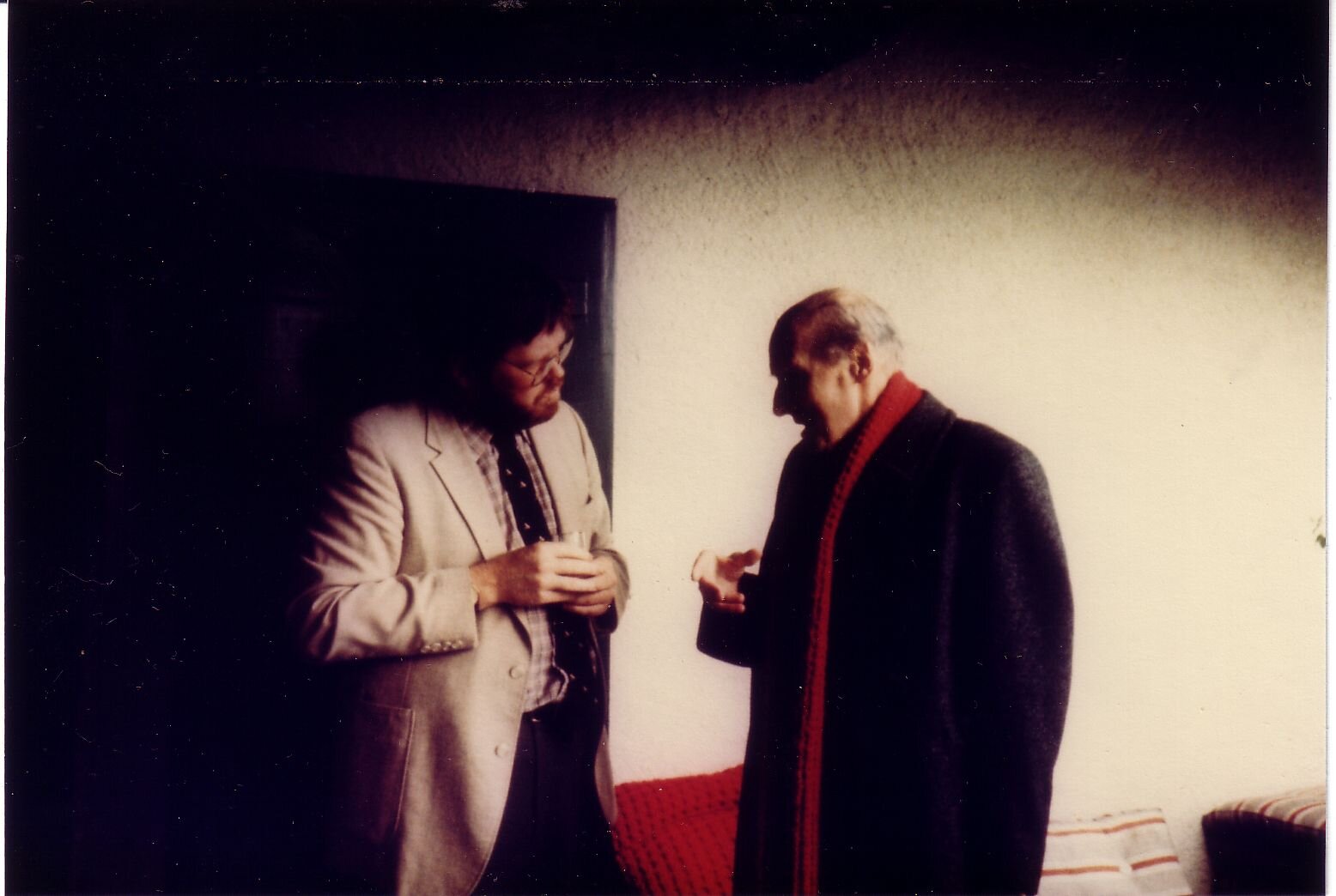
with Swiss composer Peter Mieg
On working with composers
I started to play new music a few years after I started lessons. In school I met composers who made me curious, and I began to present their efforts. I joined new music ensembles in Los Angeles and had the opportunity to work with some important composers.
I guess the most famous was Roy Harris (1898-1979), whose Symphony 1933 was the first to be recorded by an American composer. His visibility grew and by 1939 wrote his Third Symphony, now a standard classic. He wrote a fair amount of chamber music and taught many composers including William Schuman and Peter Schickele (of PDQ Bach fame). I met him while working on the cantata Abraham Lincoln Walks at Midnight, with his pianist-wife Johana. I really connected with Roy and Johana. I loved her sensitive playing. I wanted to play a cello work of Roy’s, and the cello sonata (written for Starker) was given to me to consider. After some weeks of working on it with Johana, we found it wanting. Roy decided to re-write it and called it Duo. We premiered it in New York on my debut recital and recorded it in their home with Roy supervising.
I often came to visit Roy. He always greeted me, “Ce-llo, Terry”, had a glass of sherry and trotted off to the Malibu Sea Lion, a great restaurant on Pacific Coast Hwy. We had many interesting conversations. I loved the story about Bernstein and the 3rd symphony. Roy came to a rehearsal but Bernstein really hadn’t thoroughly studied the score. At the break he asked Roy what he thought. Roy said, “Let’s just take it out to the alley and piss on it.” The next day Bernstein showed up, unshaven, but he memorized the piece and gave a stellar performance. There are more stories but maybe save them for another day.
Paul Creston (1906-85) was one of the most performed American composers from the late 30s-50s. He wrote several symphonies, all recorded multiple times, chamber music (of which his String Quartet was championed by the Hollywood Quartet). While in residence at Grinnell College, we were provided funds to commission composers. We thought to commission first those of the older generation who hadn’t written a trio. It’s such a curious thing. All the great trios were written by composer-pianists, like Beethoven, Brahms and Mendelssohn. That seemed to die with Ravel and Reger. It’s stunning to realize that for such a standard ensemble many great composers ignored or were not approached by ensembles. Stravinsky, Hindemith, Bartok, Barber, Strauss, Prokofiev left us nothing. Some only brushed with it in their student days like Sibelius, Britten, Elgar and Nielsen. We asked Barber, Brubeck, Copland, Bernstein, William Schuman, Schifrin, Chavez, Thomson and others but they couldn’t commit for various reasons. Creston was on our list and I was assigned to contact him. He couldn’t have been more gracious. He loved our playing too.
We premiered his lovely trio with Public Television on hand and later recorded it. It’s so good to have this memento of a rewarding association. Creston was an autodidact and worked many jobs during the Depression. He kept up his composing at night, staying awake by smoking coffee grounds in his pipe when he wasn’t accompanying for films on organ or for church services. He later held teaching positions and taught the likes of John Corigliano and Gerard Schwarz.
During our association I asked for a cello concerto, and he started it with excitement. He called the piece Sadhana and the premieres were done within a consortium of orchestras who were able to provide a proper commission and featured their principal cellists. Paul arranged the final emotional peak of the piece for me for cello and piano (Cantilena).
Our violinist, the late Kenneth Goldsmith, was a charismatic musician with a long and varied career. He knew and worked with many composers and on the West Coast, Lou Harrison was one of his dear friends. Lou is a wonderful composer, but by the time we were offering a commission, he hesitated. He was immersed with the music of Java and its gamelan ensembles of varying tuning systems. What came of that initiative was the concerto for violin, cello and gamelan, which we performed recorded with Lou and his ensemble. We still pursued him for a trio even though he kept complaining about the Western-tuned “damned pie-ana” , but he finally relented and we now have a wonderful piano trio (published by C.F. Peters).
A composer who will always be a part of the American pioneers is Otto Luening. Otto had a very long and fruitful life having been born in 1900. He was also a conductor and played flute and piano, but he will always be known as one of the very first tape and electronic composers along with Ussachevsky and founded the Columbia-Princeton Electronic Music Center. He taught many important composers including Chou wen-Chung, Corigliano, Wuorinen, Tower and Sollberger.
For many years during the summers, we were in residence at the Greenlake Festival in Wisconsin. The Festival offered us a commission and we thought Wisconsin native Otto would be perfect. He was in his 90s but as sharp as ever. We got on marvelously. He and his wife decided to come for the premiere and supervise the recording sessions. This ended up being his last trip from NYC. Otto and I developed a great friendship. I loved hearing him talk about his father who played flute in Bayreuth under Richard Wagner. Can you imagine talking to someone who, within one lifetime, could authentically relate an event in the 1880s? I asked what his father remembered about it. It was the Beethoven 9th and during the Adagio stopped the orchestra and said, “Gentlemen, we cannot play this music too slowly.” And he also told us about studying with the great Busoni who encouraged Otto’s independence. We recorded his early trio, a powerful piece from this period. He wrote a trio for us called Fantasia no.2, and for me a solo sonata and the last piece he wrote, a little concert piece for cello and chamber orchestra. Otto was a very sensitive person and would call me to check in to see how I was doing. He knew I wrestled with depression and the musician’s plight.
Known for his film scores and the ubiquitous theme to Mission Impossible, Lalo Schifrin was a composer of concert music first, and wrote colorful scores, a master of orchestration. While going through Gregor Piatigorsky’s library I came across the score to his Schifrin’s 1966 Double Concerto. It is a huge score and was unplayed. A commission from Piatigorsky for him and Heifetz, it came too late in their career to go beyond the exploratory period—the working out of ideas phase, making suggestions and changes. By then they didn’t take on new pieces for concerts though Piatigorsky tried. He also made an effort to get Walton on board for a concerto or rhapsody, but the composer insisted on a firm premiere date, and the idea evaporated.
I got in touch with Lalo and made a deal with him. I would make a professional score and parts if he would allow Laura Bossert and me to premiere it. He agreed. We met him at his house in Beverly Hills (a former home of Groucho Marx) and played through the piece with piano. I was able to interest the Lubbock Symphony and Texas Tech University to sponsor the event and bring the composer to the premieres. What a piece! As an encore we surprised him with my little arrangement of Mission for violin and cello alone; the orchestra wore sunglasses as we played. He loved it.
I could go on, and maybe I will later, but I thought I’d leave you with one of my “brush with greatness” moments. Having just discovered early music, choral and organ music as a student, I attended a concert in Los Angeles on the Monday Evening Concert series. The repertoire intrigued me--Monteverdi’s Vespers; all I knew is that I liked his music. The concert was conducted by Robert Craft, Stravinsky’s assistant. How surprised we in the audience were to see Stravinsky in the first row with his wife. I was in the middle of the hall and all I could see was to top of his head. When intermission came I fearlessly marched to the front of the hall and introduced myself. He was buried in the chair, so I knelt down to be at eye level. He couldn’t have been nicer. His wife was concerned but he gave her a wave of “not to worry.” I offered my left hand and rather than shake grabbed my thumb. He felt the callous, looked at me and asked, “Are you a cellist?” I couldn’t believe it! I then babbled on about that I thought he was the greatest composer since Bach, and eventually asked him if he liked the concert. He said, “Well, if Monteverdi were alive today, I’d have a lot to say.” I asked how his health was and he pointed to a line on his cane. “You see, I took a fall and if I had fallen that much more, I would be paralyzed.” There may have been more conversation, but I don’t recall, I was in awe, besides the lights were blinking. I stood up and the entire audience was staring at me. I was oblivious to everyone. That’s the boldness of youth. I wouldn’t do that today but am I ever glad I did it.
Selection of Published Commissioned or Premiered Trios
Barab: Three Fables for 3 narrators and piano trio: Seesaw 50500840
Chihara, Paul: Elegy for piano trio: C. F. Peters
Chihara, Paul: Trio for violin, cello, piano: G. Schirmer OR48138
Cooper, John C: “Parameter” Trio for violin, cello, piano: Parameter Publications
Cowell: Four Combinations for piano trio: C .F. Peters
Creston: Trio, op.112 for violin, cello, piano: Music Graphics Press
Dukelsky: Tema con variazioni for piano trio: Boosey & Hawkes
Drew, James: Almost Stationary for piano trio: Theodore Presser Co. 114-40205
Fine, Vivian: Trio for violin, cello, piano: Gunmar/Shawnee Press
Harrison, Lou: Concerto for violin, cello and Javanese gamelon: American Gamelon Society
Harrison, Lou: Trio for violin, cello, piano: C. F. Peters P67906
Luening: Fantasia no.2 for piano trio: ACA
Leichtling, Alan: Trio for violin, cello, piano, op.67 Seesaw Music Corp. SS 50020200
Mieg, Peter: “Mirecourt” Trio for violin, cello, piano: Amadeus BP 22
Miki, Minoru: Trio for violin, cello, piano: YUI Shuppan
Reale, Paul: Concerto “Dies Irae” for piano trio and orch: Carl Fischer, Inc.
Reale, Paul: Trio no.1 for violin, cello, piano: Carl Fischer, Inc.
Rodgers, Lloyd: Trio for violin, cello, piano: Material Press, Frankfurt am Main
Santos, Joly Braga: Trio, op.64 for violin, cello, piano: AVA
Silvestrov, Valentin: Drama, for piano trio: Belaieff Verlag BEL 684
Smyth, Ethel: Trio for violin, cello, piano: Roberton/Good Times
Sowash, Rick: 4 Piano Trios: Sowash Publishing
Svoboda, Tomas: Phantasy op.120 for piano trio: Thomas C. Stangland Co.
White, David Ashley: Elegy and Exaltation for piano trio: Southern Music Co. ST944SC/HL3775823America in Concert series at Library of Congress
Selection of Cello Works Published, Commissioned or Premiered
Barab, Seymour: Sonata for two cellos and piano: Seesaw 50001110
Cooper, John C: Hymn for Peace for cello and strings: Parameter Publications
Dvorak: Polonaise for cello and piano: Oxford University Press
Harrison, Lou: Concerto for violin, cello and Javanese gamelon: American Gamelon Society
Leichtling, Alan: Fantasy Piece no.2 for cello and piano: Seesaw 50019850
Leichtling, Alan: Sonata for cello and piano: Seesaw 50020120
Leichtling, Alan: Three Emily Dickinson Songs for bass/baritone and cello: Seesaw 50020170
Luening, Otto: Concert Piece for cello and chamber orchestra: ACA
Luening, Otto: Sonata for solo cello: ACA
Reale, Paul: Seance (at a late hour) for solo cello: T. Presser Co.
Reale, Paul: Sonata for cello and piano: Carl Fischer, Inc.
Schifrin, Lalo: Sinfonia Concertante for violin, cello, orch. (sc/pts): LKM Music
Schifrin, Lalo: Sinfonia Concertante for violin, cello, orch. (pf trio): LKM Music
Schuller, Gunther: Duo Concertante for cello and piano: Gunmar/Shawnee Press
Schuller, Gunther: Trois Hommages for 2 cellos and piano (new vers.): Gunmar/Shawnee
Sowash, Rick: Harvest Hymn and Country Dance for cello and piano: Sowash Publishing
Sowash, Rick: Cliffs Above the Clear Fork for cello and piano: Sowash Publishing
Sowash, Rick: Spring Fever Suite for 2 cellos: Sowash Publishing
Sowash, Rick: World Enough and Time: Rhapsody for cello and orchestra: Sowash Publishing
Sowash, Rick: Bright April for soprano and cello: Sowash Publishing
Stevens, Halsey: Romanian Dance for cello and piano: ACA
Svoboda, Tomas: Lullabies for violin and cello: Thomas C. Stangland Co.
Svoboda, Tomas: Suite op.147 for solo cello: Thomas C. Stangland Co.
Uspensky, Vladislav: Double Concerto for violin, cello and chamber orchestra
White, David Ashley: Four Impressions for solo cello: E.C. Schirmer 1.3412 2018
Unpublished Works:
Copland, Aaron: arrangements of Chopin piano works
Cowell, Henry: For Unaccompanied Cello
Cowell: Clestogamy for violin and cello
Cowell: Scenario for 2 violins, cello and piano
Cowell: Hymn and Fuguing Tune 15b for violin and cello
Creston, Paul: Cantilena from Sadhana, op.117a for cello and piano
Duke, John: Trio for violin, cello, piano
Duke, John: Movements for solo cello
Foss, Lukas: “Suite” [1. Capriccio] 2. Early Song 3. Dedication 4. Composer’s Holiday
Harris, Roy: Duo for cello and piano
Price, Jeffrey: Concerto Lirico for cello and orchestra
Rosza, Miklos: Two Pieces for cello and piano
Stewart, Robert: Improvisation for solo cello
Thomson, Virgil: Etude (Portrait of Frederic James) for solo cello
Uspensky, Vladislav: Suite for viola and cello
Uspensky, Vladislav: Trio for violin, cello, piano
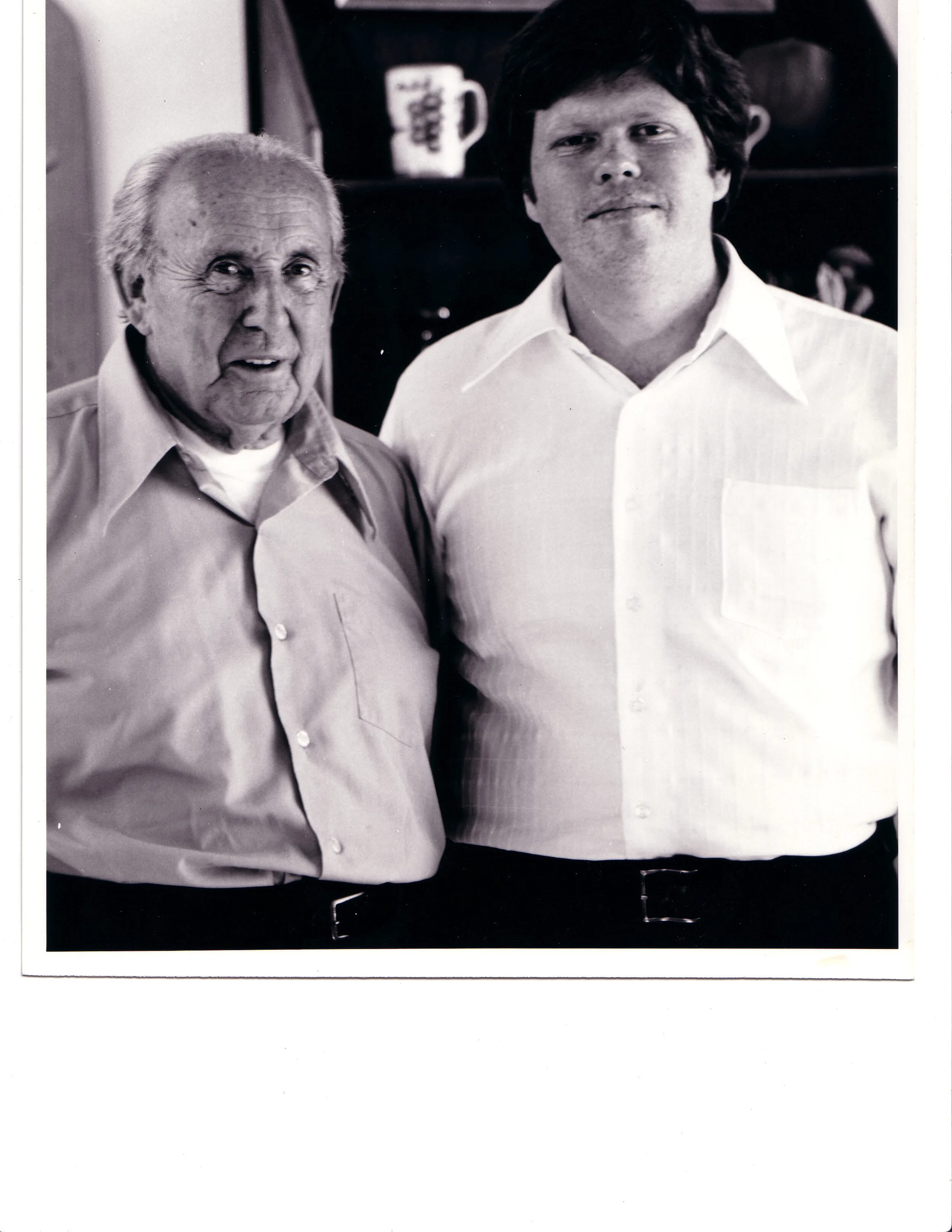
With Roy Harris

With Catherine and Otto Leuning
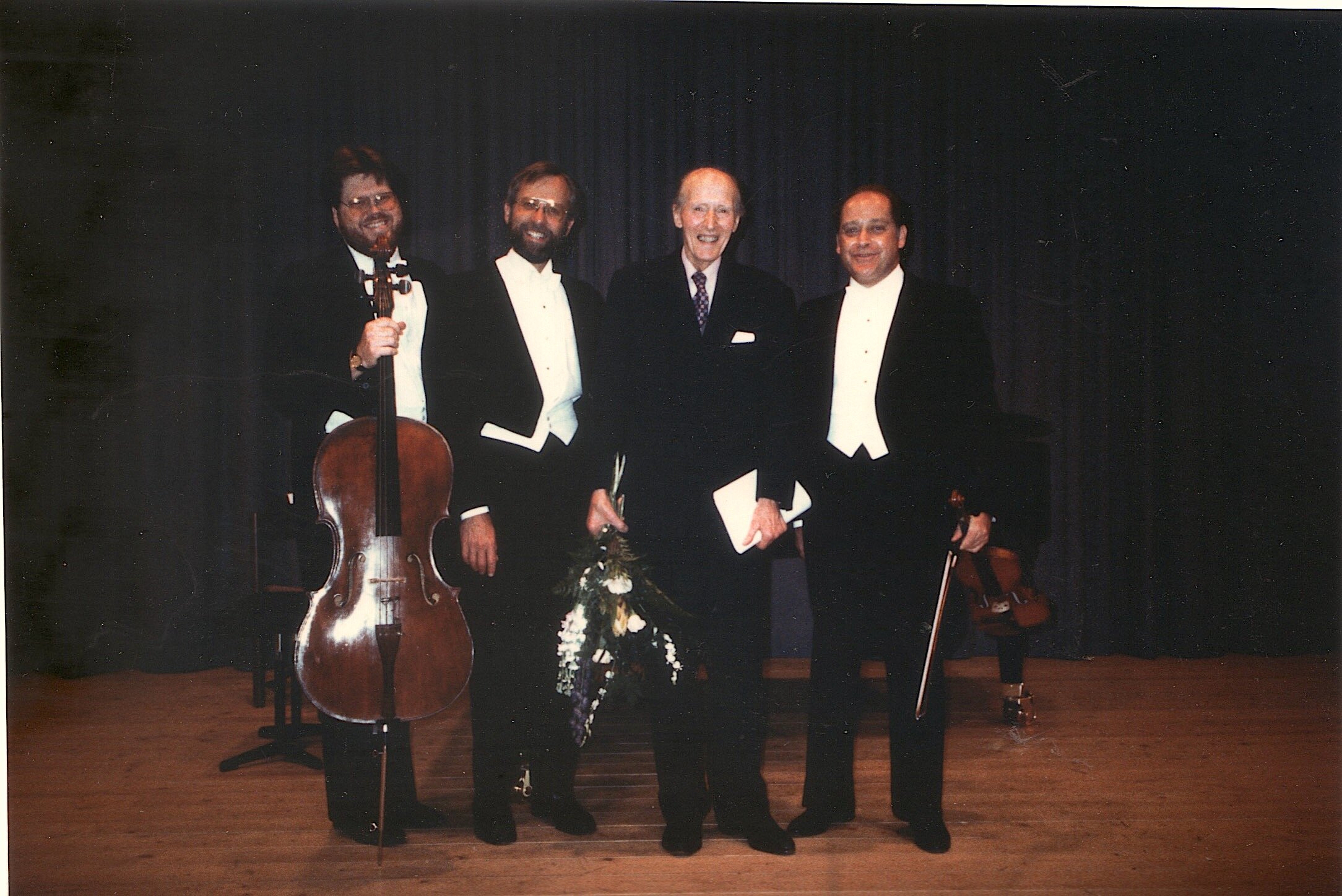
Mirecourt Trio with Peter Mieg
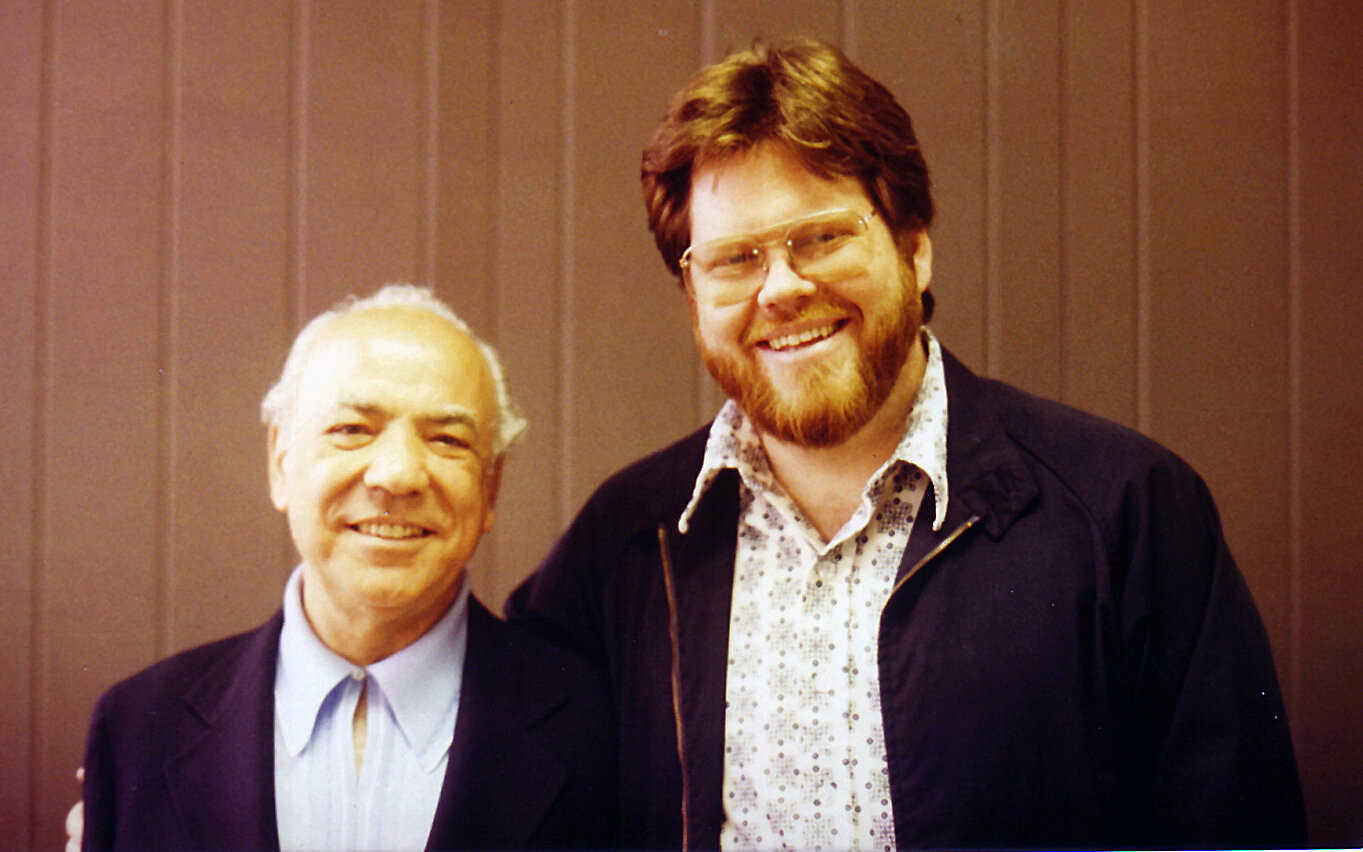
With Paul Creston

Mirecourt Trio with Paul Reale

With the (Louis) Kaufman String Quartet, Anette Kaufman, Lois Adele Kraft, and composer William Grant Still
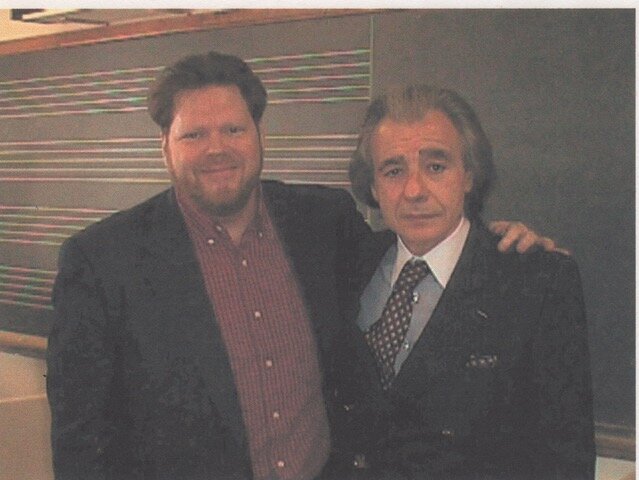
With Lalo Schifrin

With Lou Harrison and Kenneth Goldsmith
Lous Harrison: Double Concerto for Violin and Cello: I. Grandly, but moderate
Mirecourt Trio, 1981
Otto Leuning: Piano Trio No. 1
Mirecourt Trio